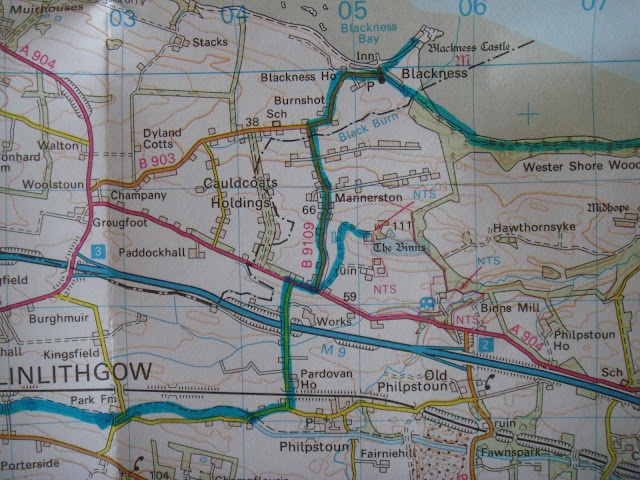Never before in the history of cycling day trips has a route inhaled so much 'Time', human and geological. Although this route is on the eastern part of Scotland (nearer Edinburgh than Glasgow), such is the speed of trains these days that it is often quicker to get to Linlithgow from Glasgow than it is to get to Dumbarton or Greenock. At any rate, distance is not an issue. From Queen Street the train to Linlithgow takes around half an hour. Linlithgow itself is like all the towns on this route replete with history, the various architectures screaming out their tales as we pass them. Linlithgow is also St. Michael's Place, and St. Michael, so the stones say, is 'kinde to strangers'. But this is the beauty of cycling like this: one's openness to one's self and to 'strangers'. I have never had so many impromptu discussions by the sides of roads as when I am cycling through towns and villages and farmsteads. I guess the bicycle is a great facilitator of union, the tacit diplomat which everyone recognizes.
.JPG)
Linlithgow's High Street
As luck would have it, I forgot my maps this morning, but I needn't have worried, the route is well-signposted much of it on extant sustrans or local authority trails. The only concern really was the small 5 mile section between North Queensferry (the north exit of the Forth Road Bridge) and Dunfermline which seemed to be mostly on shared roads. Nevertheless, the
Round the Forth Cycle Map will help here and point you in the right direction.
From Linlithgow to the Forth Road Bridge is relatively easy to follow and contains some splendid structures along the way -
From Linlithgow, follow the canal towpath for a couple of kilometres until the second road at the garden centre, then enjoy the sweep downhill towards the shore of the Forth and Blackness, passing along the way the House of the Binns. The roads here are quiet and typically rural. At the end of the road, we have the small coastal village of Blackness and its castle.
From Blackness the route 76 follows through a couple of fields and into Wester Shore Wood, a cool green zone which hugs the shoreline until more or less South Queensferry, passing such notable structures as Hopetoun House (Scotland's largest and, some say, finest stately home), and this beautiful freshly tarmacked shore road pictured below.
.JPG)
Across another fine structure, The Forth Road Bridge, aside the Forth Rail Bridge, takes us past the idyllic haven of North Queensferry onto Inverkeithing and Dunfermline 5 miles or so further on. It would be a good idea to consult the Around the Forth map here -
The haven of North Queensferry from the Forth Road Bridge.
.JPG)
Inverkeithing
Dunfermline has a host of fascinating buildings, past and present, none moreso than the abbey and the historic town. The Carnegie Library is also a fine structure in the centre of the old town.
Outside the Carnegie Library, Dunfermline.
Dunfermline's Old Town.
Lunch in the abbey's graveyard.
From Dunfermline to Alloa is a skoosh, following a converted railway line for the whole distance. About ten miles in, on this
The West Fife Way, the medieval contours of Clackmannan are visible to the south-west, contours that would have made Cezanne proud. Here, there is a brief interchange onto the path to Alloa which lies a short distance ahead.
The country lanes of Clackmannanshire, looking to the Ochil Hills.
Alloa.
Alloa itself is a fascinating place, its tower house the largest of its kind in Scotland. The town centre is replete with a variety of architectures rendering an almost skansen quality to it. The railway station is right next to Asda, so it's a good time to get an orange or two. Trains to Glasgow are once an hour, usually about quarter to the hour, and take roughly an hour (via Stirling, Larbert, Croy etc..). But it's direct, and you can space out on the train, and watch the views melt. Look out for the approach to Stirling...!



.JPG)
.JPG)
.JPG)
.JPG)
.JPG)
.JPG)
.JPG)

.JPG)






.JPG)

.JPG)








.JPG)


.JPG)

.JPG)
.JPG)
.JPG)


.JPG)

.JPG)
.JPG)
.JPG)



.JPG)
.JPG)
.JPG)
.JPG)
.JPG)
.JPG)






